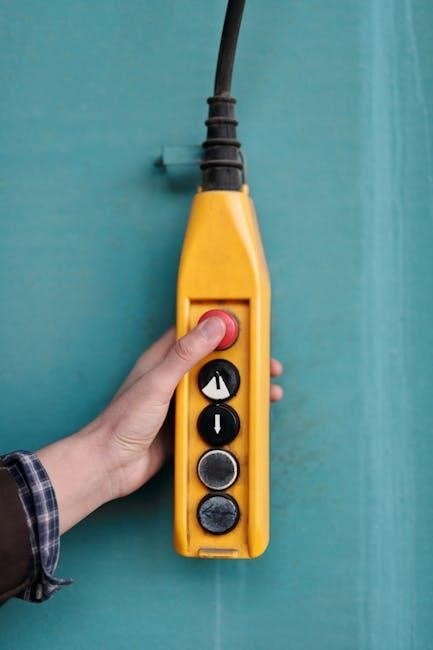x core sprinkler system manual

Hunter X-Core Sprinkler System Manual: A Comprehensive Guide

This comprehensive guide offers insights into the Hunter X-Core sprinkler system, a user-friendly solution for residential irrigation. We’ll explore installation, programming, troubleshooting, and maintenance. Learn to optimize watering schedules, understand zones, and integrate Solar Sync for weather-based adjustments. Ensure efficient lawn care with this detailed manual.
Overview of the Hunter X-Core Controller
The Hunter X-Core controller is an entry-level residential irrigation solution designed for simple operation and efficient water management. As a non-weatherproof unit, it’s ideal for indoor installations or protected areas. Its user-friendly interface allows homeowners to easily program and control their sprinkler systems, setting start times and run times for different zones.
The X-Core is compatible with the Solar Sync sensor, enabling automatic adjustments to the watering schedule based on local climate conditions. This feature optimizes water usage and promotes healthy plant growth. While it doesn’t connect to Wi-Fi or smart devices, the X-Core offers reliable performance and essential functions for basic irrigation needs. It provides multiple programs and start times, giving users flexibility in creating customized watering schedules.
Compared to more advanced controllers, the X-Core prioritizes ease of use and affordability. It’s a practical choice for homeowners seeking a straightforward solution for managing their sprinkler systems without complex features. The controller supports multiple zones, catering to various landscape requirements. Regular inspection and maintenance are crucial for ensuring the X-Core’s longevity and optimal performance. By understanding its features and functions, users can effectively manage their irrigation and conserve water.
Installation Guide for the X-Core Controller
Proper installation of the Hunter X-Core controller is essential for its reliable operation. Begin by selecting a suitable indoor location or a protected area shielded from direct sunlight and extreme weather conditions. Ensure the mounting surface is stable and accessible for wiring and programming.

Before starting, turn off the main power supply to the existing sprinkler system. Mount the X-Core controller securely using the provided screws. Connect the zone wires from the sprinkler valves to the corresponding terminals on the controller, ensuring each wire is firmly attached. Connect the common wire to the designated terminal. Next, connect the power transformer to the controller and plug it into a nearby electrical outlet.
If you’re integrating a Solar Sync sensor, follow the manufacturer’s instructions to connect it to the appropriate terminals on the X-Core. Once all wiring is complete, turn on the main power supply. Verify that the controller powers on correctly. Test each zone individually to ensure the sprinkler valves are functioning as expected. Refer to the X-Core manual for detailed wiring diagrams and troubleshooting tips. A well-executed installation ensures optimal performance and longevity of your sprinkler system. Remember to consult a professional if you encounter any difficulties during the installation process.
Programming the Hunter X-Core: Setting Time, Date, and Watering Schedules
Programming your Hunter X-Core controller involves setting the current time, date, and creating customized watering schedules to meet your lawn’s specific needs. Begin by turning the dial to the “Set Time/Date” position. Use the “+” and “-” buttons to adjust the hour and minute, then press the right arrow to advance to the next setting. Repeat this process to set the current date, including the year, month, and day.
Next, turn the dial to one of the three available program settings (A, B, or C). Each program allows you to create independent watering schedules. Within each program, you can set multiple start times. Use the “+” and “-” buttons to adjust the start time, then press the right arrow to move to the next start time. Set the desired run time for each zone connected to the controller. The run time determines how long each sprinkler zone will water during each cycle.
You can also customize the watering frequency by selecting specific days of the week or setting an interval watering schedule. Once you’ve configured your watering schedules, turn the dial back to the “Run” position to activate the programmed settings. The X-Core will automatically water your lawn according to the schedules you’ve created. Regularly review and adjust your watering schedules based on seasonal changes and weather conditions to ensure optimal water conservation and lawn health. Consult the user manual for more detailed instructions and advanced programming options.
Understanding Zones and Stations on the X-Core
The Hunter X-Core sprinkler system operates on the principle of zones and stations, which are fundamental to understanding its functionality. Each zone represents a distinct area in your landscape, such as the front lawn, backyard garden, or flower beds. A zone is connected to the controller via a station, which is a numbered terminal on the X-Core. The number of stations on your controller, typically ranging from 2 to 8, determines the number of independent zones you can control.
Each station is wired to a specific sprinkler valve that controls the water flow to its corresponding zone. When a station is activated, the connected valve opens, allowing water to flow through the sprinklers in that zone. Understanding the relationship between zones and stations is crucial for programming and troubleshooting your X-Core system.

Before programming, identify which station corresponds to each zone in your landscape. This can be done by manually activating each station and observing which sprinklers are operating. Once you’ve mapped your zones to their respective stations, you can program watering schedules for each zone individually, tailoring the watering duration and frequency to the specific needs of that area. Properly understanding zones and stations ensures efficient and targeted watering throughout your landscape.
Manual Operation of the X-Core Controller
The Hunter X-Core controller offers a straightforward manual operation mode, allowing you to override programmed schedules for immediate watering needs or testing purposes. This feature is particularly useful when you need to water a specific zone outside of its regular schedule, such as after planting new vegetation or during periods of unusually dry weather.
To initiate manual operation, locate the dial on the X-Core controller and turn it to the “Manual Single Station” position. This setting allows you to manually activate one zone at a time. Once selected, use the “+” or “-” buttons to choose the desired station, corresponding to the zone you wish to water. After selecting the station, set the desired run time using the same buttons, specifying how long the zone will be watered.
Once the station and run time are set, turn the dial to the “Run” position to immediately start the manual watering cycle. The selected zone will water for the specified duration, after which the system will automatically stop. To halt the manual cycle prematurely, simply turn the dial back to the “Run” position. Understanding and utilizing the manual operation feature provides flexibility and control over your sprinkler system, allowing you to address specific watering needs as they arise.
Troubleshooting Common Issues with the X-Core System
The Hunter X-Core system, while reliable, can occasionally encounter issues. One common problem is a zone not watering. First, check the wiring connections to the valve for that zone, ensuring they are secure and free from corrosion. Inspect the solenoid on the valve itself; it may need replacement if faulty. Also, confirm that the master valve (if installed) is functioning correctly.
Another frequent issue is the controller not following the programmed schedule. Verify that the current date and time are set accurately on the controller. Ensure that the start times and run times for each program are correctly configured and not overlapping. Check the Seasonal Adjust setting, as an incorrect adjustment can significantly alter watering durations.
If sprinklers are not turning off, the rain sensor might be the culprit. Manually test the rain sensor to ensure it’s functioning correctly; it should interrupt watering when wet. Finally, examine the wiring connecting the controller to the valves, looking for any damage or breaks. By systematically addressing these potential issues, you can effectively troubleshoot and resolve common problems with your X-Core system.
Integrating Solar Sync for Weather-Based Adjustments
The Hunter Solar Sync is a valuable addition to your X-Core system, enabling weather-based adjustments to your watering schedules. This intelligent sensor automatically modifies irrigation run times based on real-time weather conditions, optimizing water usage and promoting plant health. Installation involves mounting the Solar Sync sensor in an open area where it can accurately measure sunlight and temperature.
Once installed, connect the sensor to the designated terminals on your X-Core controller, following the wiring diagram provided in the Solar Sync manual. Activate the Solar Sync feature within the controller’s settings. The system will then begin collecting weather data and adjusting watering durations accordingly, reducing water waste during rainy periods and increasing irrigation during hot, dry spells.
Regularly check the Solar Sync sensor for obstructions, such as overgrown vegetation, which could affect its accuracy. By integrating Solar Sync, you can automate your watering schedule and ensure your landscape receives the precise amount of water it needs, contributing to water conservation and a thriving garden.
Winterization and Maintenance Tips for Your X-Core System
Proper winterization and regular maintenance are crucial for extending the lifespan of your Hunter X-Core system and ensuring optimal performance. Before freezing temperatures arrive, it’s essential to drain your sprinkler lines to prevent damage from ice expansion. Begin by shutting off the water supply to your system. Next, open all drain valves on the main line and at the end of each zone to allow water to escape.
Consider using an air compressor to blow out any remaining water from the lines, ensuring they are completely clear. Disconnect the X-Core controller from its power source to protect it from power surges during winter storms. Store the controller in a dry, protected location if possible.
Throughout the year, inspect sprinkler heads for damage or clogs, replacing or cleaning them as needed. Check for leaks in the pipes and fittings, repairing them promptly to prevent water waste. Regularly clean the controller’s housing to remove dust and debris. By following these winterization and maintenance tips, you can keep your X-Core system in top condition for years to come.

Inspecting and Maintaining Sprinkler System Components
Regular inspection and maintenance of your sprinkler system components are vital for ensuring efficient and effective irrigation. Begin by visually inspecting all sprinkler heads for any signs of damage, such as cracks, breaks, or misaligned nozzles. Replace any damaged heads immediately to prevent uneven watering and water wastage. Check the spray patterns of each head to ensure they are providing adequate coverage to the designated areas.
Clear any obstructions, such as grass or debris, that may be blocking the spray. Inspect the valves for leaks or malfunctions, and repair or replace them as needed. Examine the pipes for cracks, leaks, or signs of corrosion. Address any issues promptly to prevent further damage and water loss.
Clean the filters regularly to remove debris and prevent clogs. Check the controller for proper functioning and ensure that all settings are accurate. By following a consistent inspection and maintenance schedule, you can prolong the life of your sprinkler system and optimize its performance, saving water and money in the long run. Regular maintenance prevents costly repairs.
Safety and Emergency Protocols for Sprinkler Systems
Ensuring safety around sprinkler systems is paramount, especially during operation and maintenance. Before commencing any work, always turn off the main water supply to the system to prevent accidental spraying or flooding. Wear appropriate protective gear, such as gloves and eye protection, to safeguard against potential hazards like sharp objects or chemicals.
In case of a fire, sprinkler systems act as a crucial first line of defense. Familiarize yourself with the manual operation protocols to assist in fire suppression efforts, if safe to do so. Immediately contact emergency services and activate the fire alarm system. Regularly inspect the system for any signs of damage or malfunction that could compromise its effectiveness in an emergency.
Be aware of the location of all system components, including the main shut-off valve, in case of a burst pipe or other emergency situations. Educate all household members on the importance of sprinkler system safety and the steps to take in case of an emergency. By adhering to these safety protocols, you can minimize risks and ensure the safe and effective operation of your sprinkler system.



Leave a Reply
You must be logged in to post a comment.